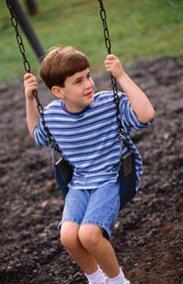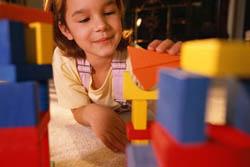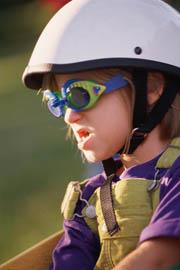Protecting Your Children
You and your children should understand that awareness, avoidance, and prevention are the most important principles of personal safety and self defense. This is especially true for small children because they may have difficulty recognizing dangerous situations, and defending themselves against adults and older teenagers.
Fill out and keep a Rocklin Police Department Child Identification Kit on hand for each child. The kit includes a place for a current photograph, a hair sample, and a fingerprint card. A current picture is one of the most valuable things you can have on hand if your child is lost or abducted. The police department does not keep a database of child fingerprints, so if you do fingerprint your children, keep the cards in a safe place.
Keep a Close Watch
Keep your kids close to you. Having your child hold your hand or wear a safety harness attached to you are two good ways to keep them close when you are in a public place. Small children participating in group activities should be assigned a buddy. The buddy concept means that one child watches out for the other, and doesn’t go anywhere without his/her buddy. It takes a great deal of concentration to keep watch over children. It can be especially difficult when there are multiple kids and multiple parents. It is very important that there be clear instructions as to which parents are responsible for maintaining “watch” during specific time periods. This assignment should change periodically to allow for breaks and down time.
When left unsupervised, small children have been known to crawl or walk right out of their own residence. Therefore, it may be necessary and advisable to install internal latches on doors that are mounted high enough so small children cannot reach them. A door and window chime system can also alert you to the fact that someone has come in or out. Do not install a double cylinder deadbolt lock (a lock with a key on the inside). These locks can prevent children and adults from exiting during a fire or other emergency.
Take the time to secure your home. Leaving doors and windows unlocked creates opportunities for criminals to enter your home. Invest in a burglar alarm for extra security.
Form a Neighborhood Watch group so you and your neighbors can watch out for each other.
Dangers in the Home
Children are susceptible to many dangers around the home. Take the time to inspect every part of your home (inside and out) and make sure to remove or mitigate potential hazards.
Children who fall into swimming pools, ponds, bathtubs, buckets, fountains, aquariums, and even toilets can drown in a matter of a few seconds. Swimming pools should be properly fenced and gated. Swimming pool alarms that ring when someone enters the water can be a great investment.
Make sure suffocation hazards such as ice chests and plastic bags are properly secured and are not accessible to children. Small children are naturally curious, so keep them out of areas where they may crawl into dangerous places. Refrigerators, freezers, driers and other appliances also pose “crawl-in” hazards.
Remove choking hazards such as coins, buttons, candies, etc. from the reach of infants and small children.
Since small children like to climb, make sure furniture and appliances are secured so they will not fall on children.
When cooking, keep pots and pans away from the front edge of the stove whenever possible, and turn handles away from where they can be easily grabbed.
Keep cleaners, chemicals, medicines, etc., out of the reach of children and preferably in a locked cabinet.
Take precautions around electricity. Make sure to remove all appliances from around sinks, bathtubs, pools, etc. Use special electrical outlet plugs to keep children from touching or placing objects inside electrical sockets.
Store firearms in a locked safe or container. Using trigger locks and keeping ammunition separate from the firearm can also help avoid serious accidents.
Street Smarts
Children under 18 years of age must wear a properly secured and fastened helmet when they ride a bicycle or motorized scooter. Children under 16 years old may not ride motorized scooters.
Children who are under 6 years of age or 60 pounds must use a child safety restraint system when being transported in a motor vehicle.
Do not leave young children in a vehicle while you are shopping, dropping off things at the cleaners, etc. It is unsafe and it is against the law.
No matter how safe or secure your street feels, it is still risky to let small children play in the front yard without adult supervision. It only takes a moment for a stranger to enter an area and abduct a child.
Map out safe and well-traveled routes for your children. Do not allow them to take shortcuts through dangerous areas.
Avoid Strangers
Consider allowing older children to carry personal sound alarms that they can activate if a stranger confronts them. These alarms can be heard from hundreds of feet away, and can help to scare off an abductor and to alert parents of a problem. Parents need to make sure their children are mature enough to carry such a device. These alarms are loud enough to damage eardrums, so care needs to be taken to make sure children use them properly.
Get to know who your children are spending time with. Write down their names, addresses, and phone numbers, and familiarize yourself with their parents. If you allow your children to visit a friend’s house, meet the family first to make sure you are comfortable with the supervision and the environment.
Protect their Identity
Do not allow your children to carry, wear or ride anything with their first or last name written on it (in large letters). This can provide a criminal with your child’s identification. A stranger can get their attention by calling out their name, or even look up their last name in a phone book to see where they live.
Use common sense when creating a phone message for your answering machine. Don’t advertise that you have kids, and don’t let children take part in recording the message.
Leaving small toys outside in the front yard advertises that children are present in your household. It can also create an opportunity for a stranger to lure your child away with his/her own toys.





